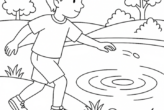Understanding the Dynamics of Coloring Therapy for Children
By Best Coloring PagesJuly 29th 2018
While traditional therapy offers numerous advantages for children, it may be difficult and even frightening for them to properly express themselves in a clinical-based environment; however, coloring therapy is often fun for the child and may provide a clinical breakthrough for them.
What is Coloring Therapy?
Coloring therapy is a form of art-based psychotherapy that is designed to allow children to communicate the thoughts, emotions, and feelings to professionals that have a desire to understand and help them cope with the challenges that they face in life. In most instances, coloring therapy allows a child to escape from the stressors of life, the complications of an illness, and/or the challenges of a disability. It is a language form that allows a child to discuss their artwork and how it relates to that which they are attempting to cope.
Why is Coloring Therapy a Popular Option for Children?
Children have the tendency to be naturally creative. It is much easier for most to color a picture and make it their own over having an open discussion based on direct questioning. Certain children may clam up or even suffer from anxiety when having certain discussions. Talking face-to-face with a therapist that asks intrusive questions may be uncomfortable for a kid; however, coloring and creating art is considered to be a non-threatening activity. Having a child color a picture and add their own touch to the piece and then discuss it is a much more productive way to achieve success in therapy – which is, to get to the heart of the problem and attempt to resolve the issues the child is experiencing.
Ways Coloring Can Help
Coloring therapy can help a child with a wide range of issues. These include – but, are not limited to – the following:
- Coping with the death of someone they are close to
- Various types of trauma experienced, such as physical abuse
- Disabilities that impact their ability to learn new skills and concepts
- Emotional complications
- Optimizing their intellectual abilities
- Coping with the challenges associated with a psychological or physiological condition
- Behavioral problems
- Alleviating stress levels
- Optimizing personal awareness
- Developing coping skills that are considered to be healthy
The Way It Works
In most instances, a therapist will provide a child with a coloring sheet and a wide assortment of utensils and art supplies. Once the child starts the sheet, the therapist may request that they add a favorite toy or place to the picture. As the session continues, the child will be asked to include important people, events, or other areas of interest. Once the picture is finished, the therapist will then ask the child to decipher their artwork. They will take note of the child’s emotions and the way that they behave during the decipher process. This helps them to better understand the child. Then, they will come to a solid resolution about a treatment that will benefit the child. If you want to help a child that is dealing with an issue, coloring therapy is the way. Visit us today for free coloring pages to get started: https://www.bestcoloringpagesforkids.com/
Resources:
https://www.artsy.net/article/artsy-editorial-art-therapy-helping-children-autism-express
https://www.psychologytoday.com/us/blog/arts-and-health/201601/child-art-therapy-how-it-works
https://www.allpsychologycareers.com/topics/art-therapy-techniques.html



